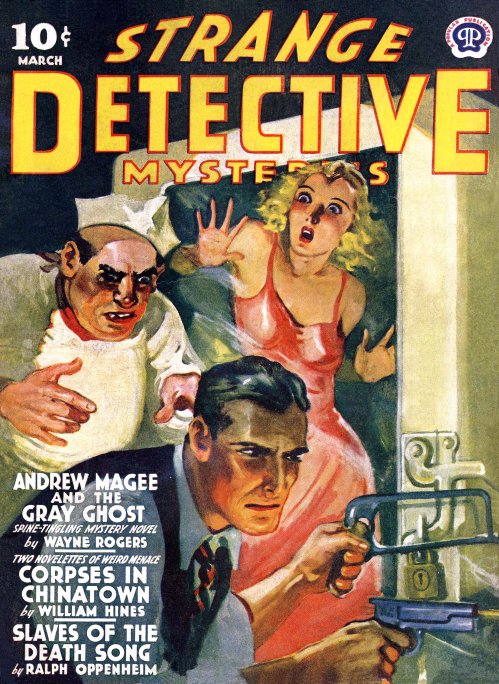
Bet you thought I forgot about this series, huh? Not so: I needed a little time to take a broader look at the field. (Click here for Part 1 and Part 2.) Someone told me that a lot of 1930s/40s/50s pulps were being scanned and posted on Usenet at alt.binaries.pictures.vintage.magazines, so I went up there and pulled down a representative sample. And I’m not talking SF anymore; what I grabbed were things like Air Wonder Stories, Mammoth Western, Strange Detective Mysteries, Adventure, and Spicy Stories.
It’s been wonderful fun. In fact, it’s a lot like watching campy old b/w TV shows, only better, because I can decide how everybody and everything looks. I don’t have to be appalled (or giggle) at the cheap crappy special effects. I just willingly enter a world in which nobody rolls their eyes at a homicidal supermarket butcher about to strangle a square-jawed hero armed with a pistol in one hand and a hacksaw in the other. (See above. No, I didn’t read that story. I still wonder what the hacksaw was about.)
I’m not the first to suggest that the pulps vanished largely because TV took over their niche. The pulps were Saturday-morning movie serials that you could enjoy any time you wanted, and once TV started showing Commando Cody, Bomba the Jungle Boy, Flash Gordon, and made-for-TV adventures like The Texas Rangers, Sky King and Highway Patrol, much of the money went out of pulp publishing. The financial pressure was eventually fatal, but over the short term, as the pulps dwindled, their quality went up. And it wasn’t just that we knew more about science and technology and hence could write better SF. The SF of the Thirties was awful because the readership didn’t care. The pulps had a monopoly on cheap entertainment and people bought it because it was all there was, and reading it was better than staring at the wall.
Print entertainment evolved out of the pulps and into other print markets, particularly glossy mags. The railroad pulps died, but glossy, ad-supported magazines like Trains and Railroad picked up the readership, which after WWII had more money to spend on locomotive picture books and model railroading. Tacky text-porn mags like Spicy Stories (which had racy drawings and a handful of “artful” b/w nude photos) gave way to Playboy and its cheaper imitators as social strictures against visual porn weakened in the 50s. In the late 50s, pulp SF improved hugely, and bootstrapped itself into the new world of mass-market paperbacks by selling reprint anthologies of the best work to come out of the pulp era. (We can be fooled into thinking 30s and 40s pulp SF was better than it was because what we read of it was hand-picked for quality decades after its publication. Read a couple of original SF pulps circa 1935 and you’ll see what I mean.) Crime pulps went both up and down, to comics on the low end (much of “crime” fiction from the Depression was actually horror) and to book-length mysteries on the high end. The romance pulps like My Romance split similarly into gossip mags and mass-market romance novels.
Fewer people may be reading these days, but those who gave it up probably never liked reading that much to begin with. Again, reading was better than staring at the wall, but TV, when it arrived, was easier, especially for people with marginal education. The audience that remained was pickier, and many had been formally exposed at the college level to classic literature, which became the standard by which all fiction was measured.
And that may be a mistake. (I’ll come back to this point in a future entry.)
Leaving the quality of the writing itself as a separate issue, after a good long look around I’d say that the lessons of the pulps are these:
- The pulps were about specific cultures. They were tightly linked to a time and a place and a generally understood cultural subtext. This was even true of early pulp SF, much of which might be characterized as “Depression-era Chicago on Mars.”
- Characters were intended as costumes to be worn by readers, not fully realized individuals to be admired on their own merits as independent men and women. A lot of people don’t understand this, and many still won’t admit it. Make characters too vividly fluky and original, and readers will have a hard time identifying with them.
- As a corollary to the above: Concepts, settings, and action were as important as characters, and much more vivid. Again, it’s the difference between imagining yourself driving a fast car and imagining someone else driving it.
- The pulps were fun. They understood and accepted their role as immersive entertainment. They were not equipped to be literature and didn’t try to be literature.
With all that in mind, the big questions become: Is there unmet demand today for good-quality immersive (non-literary) fiction? How much of this legacy can we retrieve in 2010 and do well?
More next time.

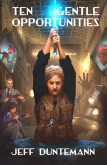

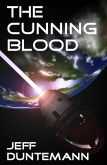


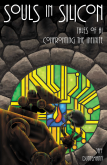
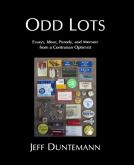



> I still wonder what the hacksaw
> was about.
It looks like the girl was locked in the meat freezer and the hero is trying to saw through the lock.
> Is there unmet demand today for
> good-quality immersive (non-literary) fiction?
I would enjoy hearing your thoughts on Second Life, World of Warcraft and where you think it’s all going.
-David
Stay tuned–I’m getting to that.
The Z-order on the art threw me off there: The girl’s head is in front of the magazine title art, which in turn is in front of the freezer, suggesting that she’s in front of the art and therefore in front of (and out of) the freezer.
Somehow I’m guessing nobody back then thought it through that thoroughly–or much cared. (“Girl locked in a freezer” was probably a standard true crime/horror element back in the day.)
The “jumping in front of the title” motif is so common it probably has a name. Anyone know if it does and what it is?
Notice also the flash coming out of the gun; he’s shooting at someone right then.
Also notice the girl’s hands, which appear to be splayed against the glass door of the freezer. (More likely a cooler – freezers usually don’t have glass fronts.)
‘Course, if the door weren’t transparent how would you know there was girl in there?
In the day, you bought the magazine because the cover attracted; you didn’t read the story to better understand the cover. Nowadays, of course …
Jeff, I am a newbie at this stuff. How do you access the scanned files?
Bob
I use an ordinary newsreader client called Pan, but newsreaders are all over the place. Forte Agent is probably the best known commercial example, but for what relatively little I do with Usenet, Pan is more than enough. Once you have a newsreader and some way of accessing Usenet (your ISP may or may not offer access) bring down the list of newsgroups, select the one you want to read, and tell the newsreader to bring down headers for that group. It’s almost precisely like bringing down the subject lines from a lot of email but not bringing down the message bodies themselves. Some headers will have binary attachments while others will only have plain text bodies. Select the message you want, and direct the newsreader to bring the message body and/or attachments down. How that’s done varies with the newsreader itself, but that’s how it works from a height.
Since the apparent bad guy is dressed like a butcher, that may actually be a bone saw. But maybe they cut through locks just as well as regular hacksaws.
I don’t think a bone saw would cut a lock hasp, since most of those are hardened steel. (And it takes a long time even with a good hacksaw.) Also, I had a bone saw briefly years back (got it in a box of odd kitchen junk at a garage sale) and I think its teeth were too large to efficiently cut steel.
Just a thought to ponder: Pulp artists probably assumed their work was meant to be quickly consumed and discarded. I wonder what they would think of people who could be their grandchildren analyzing and appreciating their work? I wonder if they would have done anything different if they knew? Any of them still living?
I went back and looked…but not only is the cover art not credited, the magazine has no masthead. So we have no idea who did the editing, the layout, the art, anything.
As for the pulps being considered disposable, that’s a fersure. I’m guessing that most of the people who were in the pulps business in 1936 are long gone, but I bet they’d get a kick out of what appears to be a resurgence of interest in the form.
A few pulp artists, like Kelly Freas and Edd Cartier, lived to see coffee table books devoted to their early work. There are interviews with both on-line, but I don’t know that they ever commented on exactly this.
Of course, the pulp writers were working with pretty much the same assumptions. A few (such as Harold Lamb and Talbot Mundy) would see hardcover print in the 30s and 40s. Most of the stf pulp writers had to wait for the post war boom, when Gnome and Fantasy Press started mining the stf pulps.
Other than a few hero pulps, like Doc Savage and The Shadow, I don;t believe that the other pulp genres were mined as thoroughly as the stf ones — not in the author’s live time certainly.
It’s possible–I’m partial to SF and thus not a reliable judge–that the SF was just better stuff, in part because at least some of it was written by people who were deeply into the SF/fantasy culture. Silverberg is a classic example, but there were lots of others. I think most of the others were write-to-order hacks who just didn’t care what the editors wanted as long as their checks didn’t bounce. SF was also a little less time-and-place specific than true crime, romance, etc. so it may have had broader appeal across time and culture boundaries. I do know that the mystery field has been mined, but I’m not sure to what extent because I don’t read that genre and never did.
The stf pulps had their fair share of “write-to-order hacks”. While browsing covers at “Galactic Cenrtral” (http://philsp.com/ ) I’ve seen names that I recognized — mostly one whom I thought of as “lower mid-list” stf writers.
You are right that most of the authors we remember are the ones who were stf fans before they became writers and wrote little outside the field. There are a few exceptions. L. Ron Hubbard was a major pulp author before Street & Smith pointed him at Campbell’s Astounding. I had noticed Clifford Simak’s name of some of those non-stf pulps, too. According to Wikipedia, he wrote “a number of” war and western stories in the late 30s and 40s.
[…] so many others. Now, precisely what I was going to do if he decided to raid the can is unclear. Per my entry for September 8, 2010, I do have a hacksaw here, but not a pistol that a bear would understand. (And bears have been […]